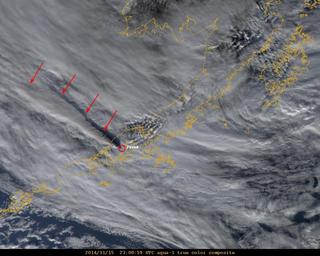Ash Plume Climbs at Pavlof Volcano

Saturday, November 15 2014

On Saturday, Pavlof's ash plume was at least 35,000 feet high, blowing for 250 miles out over the Bering Sea. /Credit: Dave Schneider/AVO
Update, 5 p.m. Saturday: Pavlof Volcano's ash plume has more than tripled in height since the eruption began -- and it's starting to affect air travel.
The eruption intensified on Saturday morning, says Dave Schneider with the Alaska Volcano Observatory.
"When it's on, it's on," he says. "There's no way to say in the midst of that when it's going to quit."
The AVO is reporting ash at least 35,000 feet high, blowing for more than 250 miles out to sea from the volcano. That's prompted the Federal Aviation Administration to put trans-Pacific flights on watch. Pilots have been asked to keep an eye out for ash near their flightpaths. They'll have to fly over it, or seek alternate routes to the south of the plume if they can't.
That's harder for local planes, which fly a lot lower than international airlines. Grant Aviation, which flies between Anchorage and Cold Bay and Unalaska, among others, isn't taking any chances. They canceled two flights today after pilots saw Pavlof's ash plume climbing this morning.
Jad Starnes works for Grant in Cold Bay. He says at their planes' low altitudes, it's hard to tell what's ash and what's cloud while they're in the air. So they're playing it safe -- and will stay on the ground until further notice.
"We have to see what sort of winds are blowing, what kind of pilot reports we start getting" before that changes, he says.
PenAir's planes fly higher than Grant's, so they've been able to work around the ash. Spokeswoman Missy Roberts says they've rerouted closer to the Pacific side of the Aleutian chain to stay upwind of the plume, which winds are carrying out over the Bering Sea. But she knows that could shift at any time.
"The winds could switch direction and change the whole ballgame again," she says.
Meanwhile, the National Weather Service is only calling for light ashfall in the uninhabited areas northwest of the volcano -- meaning Cold Bay is ash-free for now. Jad Starnes, the Grant employee, says it's cloudy there today, meaning they can't even see the volcano from town. It's about 40 miles away.
"A couple nights ago, we could see lava from our pilot house," he says.
And they'll keep watching to see what the volcano does next.
This story has been updated with new information on FAA advisories.
Update, 6 p.m. Friday: Pavlof Volcano's ash plume has almost doubled in size since its latest eruption began this week.
Dave Schneider is a geophysicist with the Alaska Volcano Observatory. He says Pavlof was blowing ash as high as 16,000 feet above sea level on Friday.
"The volcano itself is about a little over 8,000 feet, so it’s coming up a fair bit above the summit," he says.
The AVO is still seeing lava fountaining and high temperatures at the summit, too. But so far, none of that's impacting local air travel -- Missy Roberts of PenAir says they didn’t have any issues with the ash on Friday.
Still, Schneider says it's tough to predict what Pavlof will do next.
"It’s a really tricky volcano in that it doesn’t have a lot of earthquakes that happen before it erupts," he says. "It’s pretty slippery, and so magma’s able to make it up to the surface pretty easily, and by the same token it’s pretty easy for it just to continue on."
Their only clue about how long the eruption will last is what the volcano’s done before -- like this past June, when it erupted for about a week with an even higher plume that kept plenty of planes on the ground.
This is a developing story. Check back for updates.


